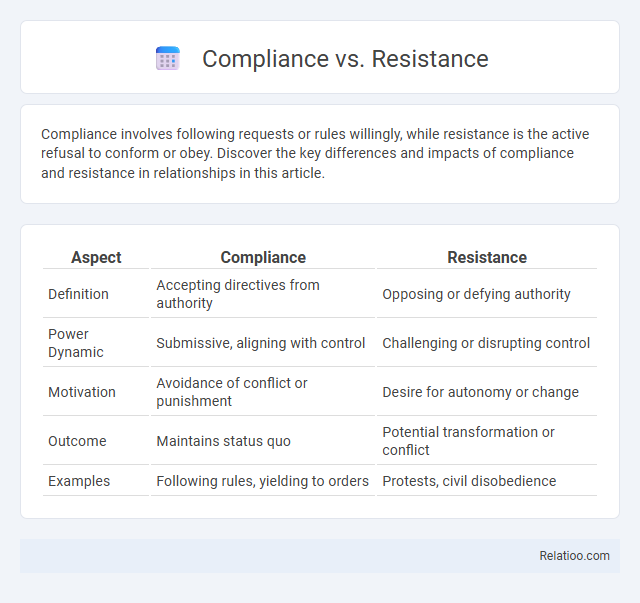Compliance involves following requests or rules willingly, while resistance is the active refusal to conform or obey. Discover the key differences and impacts of compliance and resistance in relationships in this article.
Table of Comparison
| Aspect | Compliance | Resistance |
|---|---|---|
| Definition | Accepting directives from authority | Opposing or defying authority |
| Power Dynamic | Submissive, aligning with control | Challenging or disrupting control |
| Motivation | Avoidance of conflict or punishment | Desire for autonomy or change |
| Outcome | Maintains status quo | Potential transformation or conflict |
| Examples | Following rules, yielding to orders | Protests, civil disobedience |
Understanding Compliance and Resistance
Understanding compliance involves recognizing how individuals conform to rules or requests to gain rewards or avoid punishments, often influenced by social norms and authority figures. Resistance arises when individuals actively oppose or reject directives, driven by personal beliefs, autonomy, or perceived unfairness of demands. Both compliance and resistance play crucial roles in social dynamics and organizational behavior, affecting group cohesion and decision-making processes.
Key Differences Between Compliance and Resistance
Compliance involves conforming to requests or rules often to gain approval or avoid punishment, while resistance entails actively opposing or refusing directives due to disagreement or distrust. Compliance typically reflects outward behavior changes without internal agreement, whereas resistance expresses underlying dissent and may include passive or active opposition. Understanding these differences is crucial for managing group dynamics and influencing behavior effectively.
Psychological Factors Influencing Compliance
Psychological factors influencing compliance include social norms, perceived authority, and the desire for social approval, which drive individuals to conform to requests or rules even without overt pressure. Cognitive consistency and the principle of reciprocity also play critical roles, as people comply to maintain harmony between their beliefs and actions or to return favors. Understanding these factors helps explain why compliance often occurs without direct coercion, distinguishing it from resistance or outright obedience.
Social Dynamics of Resistance
Resistance in social dynamics often emerges when individuals or groups reject compliance despite external pressures, reflecting a deliberate challenge to authority or norms. Unlike obedience, which involves following orders without question, resistance highlights active opposition that can reshape power structures and group interactions. Your ability to recognize and navigate these dynamics influences how influence and control are negotiated within social settings.
Compliance in Healthcare Settings
Compliance in healthcare settings refers to patients' adherence to prescribed medical treatments, medications, and lifestyle recommendations essential for effective care outcomes. High compliance rates are linked to improved chronic disease management, reduced hospital readmissions, and optimized healthcare resource utilization. Strategies to enhance compliance include patient education, clear communication, and personalized care plans tailored to individual needs and cultural contexts.
Resistance in Organizational Change
Resistance in organizational change emerges as a critical barrier, characterized by active or passive opposition from employees to new initiatives. This resistance can stem from fear of the unknown, loss of control, or threat to established routines, significantly impacting change implementation success. Addressing resistance through transparent communication, employee involvement, and supportive leadership enhances adaptability and minimizes disruptions during organizational transformations.
Measurement and Assessment of Compliance vs Resistance
Measuring compliance and resistance involves assessing behavioral responses to authority or social pressure using scales, surveys, and observational methods that capture the degree of conformity or defiance in specific contexts. Compliance is typically quantified through frequency of adherence to rules or requests, while resistance is evaluated by instances of refusal or counter-behavior against directives. Your analysis benefits from combining qualitative and quantitative metrics to provide a comprehensive understanding of how individuals or groups navigate demands and challenges.
Strategies to Encourage Compliance
Strategies to encourage compliance include clear communication of expectations and consistent enforcement of rules to ensure Your audience understands the benefits of following guidelines. Positive reinforcement and incentives motivate desired behavior, while building trust enhances willingness to comply. Creating an environment where feedback is acknowledged further strengthens compliance by addressing potential resistance and fostering obedience.
Overcoming Barriers to Resistance Reduction
Compliance, resistance, and obedience represent different responses to authority or requests, with resistance often stemming from perceived threats to autonomy or values. Overcoming barriers to resistance reduction involves creating clear communication, fostering trust, and aligning requests with individual motivations to encourage voluntary cooperation. Your approach should emphasize empathy and active listening to address concerns and transform resistance into compliance effectively.
Real-World Examples of Compliance and Resistance
Compliance often manifests in workplace settings where employees follow safety protocols to avoid penalties, such as wearing helmets on construction sites. Resistance can be seen in social movements like the Civil Rights Movement, where activists refused to obey unjust laws through protests and civil disobedience. These examples highlight how compliance ensures order through adherence, while resistance drives change by challenging established norms.

Infographic: Compliance vs Resistance
 relatioo.com
relatioo.com